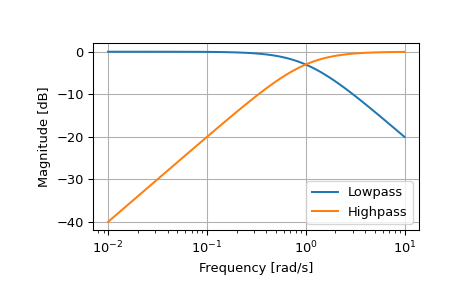scipy.signal.lp2hp#
- scipy.signal.lp2hp(b, a, wo=1.0)[source]#
Transform a lowpass filter prototype to a highpass filter.
Return an analog high-pass filter with cutoff frequency wo from an analog low-pass filter prototype with unity cutoff frequency, in transfer function (‘ba’) representation.
- Parameters:
- barray_like
Numerator polynomial coefficients.
- aarray_like
Denominator polynomial coefficients.
- wofloat
Desired cutoff, as angular frequency (e.g., rad/s). Defaults to no change.
- Returns:
- barray_like
Numerator polynomial coefficients of the transformed high-pass filter.
- aarray_like
Denominator polynomial coefficients of the transformed high-pass filter.
Notes
This is derived from the s-plane substitution
\[s \rightarrow \frac{\omega_0}{s}\]This maintains symmetry of the lowpass and highpass responses on a logarithmic scale.
Examples
>>> from scipy import signal >>> import matplotlib.pyplot as plt
>>> lp = signal.lti([1.0], [1.0, 1.0]) >>> hp = signal.lti(*signal.lp2hp(lp.num, lp.den)) >>> w, mag_lp, p_lp = lp.bode() >>> w, mag_hp, p_hp = hp.bode(w)
>>> plt.plot(w, mag_lp, label='Lowpass') >>> plt.plot(w, mag_hp, label='Highpass') >>> plt.semilogx() >>> plt.grid(True) >>> plt.xlabel('Frequency [rad/s]') >>> plt.ylabel('Magnitude [dB]') >>> plt.legend()
